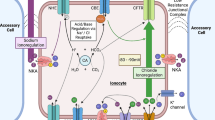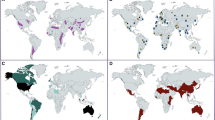Abstract
Inhalation of hyperosmotic solutions (salt, mannitol) has been used in the treatment of patients with cystic fibrosis or asthma, but the mechanism behind the effect of hyperosmotic solutions is unclear. The relation between osmolarity and permeability changes was examined in an airway cell line by the addition of NaCl, NaBr, LiCl, mannitol, or xylitol (295–700 mOsm). Transepithelial resistance was measured as an indicator of the tightness of the cultures. Cell-cell contacts and morphology were investigated by immunofluorescence and by transmission electron microscopy, with lanthanum nitrate added to the luminal side of the epithelium to investigate tight junction permeability. The electrolyte solutions caused a significant decrease in transepithelial resistance from 450 mOsm upwards, when the hyperosmolar exposure was gradually increased from 295 to 700 mOsm; whereas the nonelectrolyte solutions caused a decrease in transepithelial resistance from 700 mOsm upwards. Old cultures reacted in a more rigid way compared to young cultures. Immuno-fluorescence pictures showed weaker staining for the proteins ZO-1, claudin-4, and plakoglobin in treated samples compared to the control. The ultrastructure revealed an increased number of open tight junctions as well as a disturbed morphology with increasing osmolarity, and electrolyte solutions opened a larger proportion of tight junctions than nonelectrolyte solutions. This study shows that hyperosmotic solutions cause the opening of tight junctions, which may increase the permeability of the paracellular pathway and result in increased transepithelial water transport.













Similar content being viewed by others
References
Anderson SD, Spring J, Moore B, Rodwell LT, Spalding N, Gonda I, Chan K, Walsh A, Clark AR (1997) The effect of inhaling a dry powder of sodium chloride on the airways of asthmatic subjects. Eur Respir J 10:2465–2473
Boek WM, Keles N, Graamans K, Huizing EH (1999) Physiologic and hypertonic saline solutions impair ciliary activity in vitro. Laryngoscope 109:396–399
Boucher RC (1994) Human airway ion transport. Part one. Am J Respir Crit Care Med 150:271–281
Brannan JD, Gulliksson M, Anderson SD, Chew N, Kumlin M (2003) Evidence of mast cell activation and leukotriene release after mannitol inhalation. Eur Respir J 22:491–496
Colegio OR, Van Itallie CM, McCrea HJ, Rahner C, Anderson JM (2002) Claudins create charge-selective channels in the paracellular pathway between epithelial cells. Am J Physiol Cell Physiol 283:C142–C147
Cozens AL, Yezzi MJ, Kunzelmann K, Ohrui T, Chin L, Eng K, Finkbeiner WE, Widdicombe JH, Gruenert DC (1994) CFTR expression and chloride secretion in polarized immortal human bronchial epithelial cells. Am J Respir Cell Mol Biol 10:38–47
Daviskas E, Anderson SD, Gonda I, Eberl S, Meikle S, Seale JP, Bautovich G (1996) Inhalation of hypertonic saline aerosol enhances mucociliary clearance in asthmatic and healthy subjects. Eur Respir J 9:725–732
Daviskas E, Anderson SD, Brannan JD, Chan HK, Eberl S, Bautovich G (1997) Inhalation of dry-powder mannitol increases mucociliary clearance. Eur Respir J 10:2449–2454
Daviskas E, Robinson M, Anderson SD, Bye PT (2002) Osmotic stimuli increase clearance of mucus in patients with mucociliary dysfunction. J Aerosol Med 15:331–341
Dodoo AN, Bansal SS, Barlow DJ, Bennet F, Hider RC, Lansley AB, Lawrence MJ, Marriott C (2000) Use of alveolar cell monolayers of varying electrical resistance to measure pulmonary peptide transport. J Pharm Sci 89:223–231
Donaldson SH, Bennett WD, Zeman KL, Knowles MR, Tarran R, Boucher RC (2006) Mucus clearance and lung function in cystic fibrosis with hypertonic saline. N Engl J Med 354:241–250
Dorscheid DR, Conforti AE, Hamann KJ, Rabe KF, White SR (1999) Characterization of cell surface lectin-binding patterns of human airway epithelium. Histochem J 31:145–151
Ehrhardt C, Kneuer C, Fiegel J, Hanes J, Schaefer UF, Kim KJ, Lehr CM (2002) Influence of apical fluid volume on the development of functional intercellular junctions in the human epithelial cell line 16HBE14o-: implications for the use of this cell line as an in vitro model for bronchial drug absorption studies. Cell Tissue Res 308:391–400
Elkins MR, Robinson M, Rose BR, Harbour C, Moriarty CP, Marks GB, Belousova EG, Xuan W, Bye PT (2006) A controlled trial of long-term inhaled hypertonic saline in patients with cystic fibrosis. N Engl J Med 354:229–240
Gruenert DC, Willems M, Cassiman JJ, Frizzell RA (2004) Established cell lines used in cystic fibrosis research. J Cyst Fibros 3(Suppl 2):191–196
Henig NR, Tonelli MR, Pier MV, Burns JL, Aitken ML (2001) Sputum induction as a research tool for sampling the airways of subjects with cystic fibrosis. Thorax 56:306–311
Hirsh AJ (2002) Altering airway surface liquid volume: inhalation therapy with amiloride and hyperosmotic agents. Adv Drug Deliv Rev 54:1445–1462
Högman M, Mork AC, Roomans GM (2002) Hypertonic saline increases tight junction permeability in airway epithelium. Eur Respir J 20:1444–1448
Jongejan RC, De Jongste JC, Raatgeep RC, Bonta IL, Kerrebijn KF (1990) Effects of changes in osmolarity on isolated human airways. J Appl Physiol 68:1568–1575
Mathia NR, Timoszyk J, Stetsko PI, Megill JR, Smith RL, Wall DA (2002) Permeability characteristics of calu-3 human bronchial epithelial cells: in vitro-in vivo correlation to predict lung absorption in rats. J Drug Target 10:31–40
Matsui H, Grubb BR, Tarran R, Randell SH, Gatzy JT, Davis CW, Boucher RC (1998) Evidence for periciliary liquid layer depletion, not abnormal ion composition, in the pathogenesis of cystic fibrosis airways disease. Cell 95:1005–1015
Morita K, Furuse M, Fujimoto K, Tsukita S (1999) Claudin multigene family encoding four-transmembrane domain protein components of tight junction strands. Proc Natl Acad Sci USA 96:511–516
Morris MR, Doull IJ, Hallett MB (2001) Osmotically induced cytosolic free Ca(2+) changes in human neutrophils. Biochim Biophys Acta 1538:20–27
Nilsson H, Dragomir A, Ahlander A, Ljungkvist M, Roomans GM (2006) A modified technique for the impregnation of lanthanum tracer to study the integrity of tight junctions on cells grown on a permeable substrate. Microsc Res Tech 69:776–783
Relova AJ, Roomans GM (2001) Effect of luminal osmolarity on ion content of connective tissue in rat trachea after epithelial damage. Eur Respir J 18:810–816
Robinson M, Hemming AL, Regnis JA, Wong AG, Bailey DL, Bautovich GJ, King M, Bye PT (1997) Effect of increasing doses of hypertonic saline on mucociliary clearance in patients with cystic fibrosis. Thorax 52:900–903
Sagel SD, Kapsner R, Osberg I, Sontag MK, Accurso FJ (2001) Airway inflammation in children with cystic fibrosis and healthy children assessed by sputum induction. Am J Respir Crit Care Med 164:1425–1431
Shaklai M, Tavassoli M (1977) A modified technique to obtain uniform precipitation of lanthanum tracer in the extracellular space. J Histochem Cytochem 25:1013–1015
Shoseyov D, Bibi H, Shai P, Shoseyov N, Shazberg G, Hurvitz H (1998) Treatment with hypertonic saline versus normal saline nasal wash of pediatric chronic sinusitis. J Allergy Clin Immunol 101:602–605
Suri R, Metcalfe C, Lees B, Grieve R, Flather M, Normand C, Thompson S, Bush A, Wallis C (2001) Comparison of hypertonic saline and alternate-day or daily recombinant human deoxyribonuclease in children with cystic fibrosis: a randomised trial. Lancet 358:1316–1321
Venglarik CJ, Giron-Calle J, Wigley AF, Malle E, Watanabe N, Forman HJ (2003) Hypochlorous acid alters bronchial epithelial cell membrane properties and prevention by extracellular glutathione. J Appl Physiol 95:2444–2452
Wark PA, McDonald V, Jones AP (2005) Nebulised hypertonic saline for cystic fibrosis. Cochrane Database Syst Rev CD001506
Wen H, Watry DD, Marcondes MC, Fox HS (2004) Selective decrease in paracellular conductance of tight junctions: role of the first extracellular domain of claudin-5. Mol Cell Biol 24:8408–8417
Winters SL, Yeates DB (1997a) Interaction between ion transporters and the mucociliary transport system in dog and baboon. J Appl Physiol 83:1348–1359
Winters SL, Yeates DB (1997b) Roles of hydration, sodium, and chloride in regulation of canine mucociliary transport system. J Appl Physiol 83:1360–1369
Acknowledgements
The expert help with discussing and reviewing the electron micrographs with Dr. Agneta Lukinius as well as the expert technical assistance of Marianne Ljungkvist and Leif Ljung are gratefully acknowledged.
Author information
Authors and Affiliations
Corresponding author
Additional information
This study was supported by the Swedish Asthma and Allergy Association and the Swedish Heart Lung Foundation.
Rights and permissions
About this article
Cite this article
Nilsson, H., Dragomir, A., Ahlander, A. et al. Effects of hyperosmotic stress on cultured airway epithelial cells. Cell Tissue Res 330, 257–269 (2007). https://doi.org/10.1007/s00441-007-0482-7
Received:
Accepted:
Published:
Issue Date:
DOI: https://doi.org/10.1007/s00441-007-0482-7




